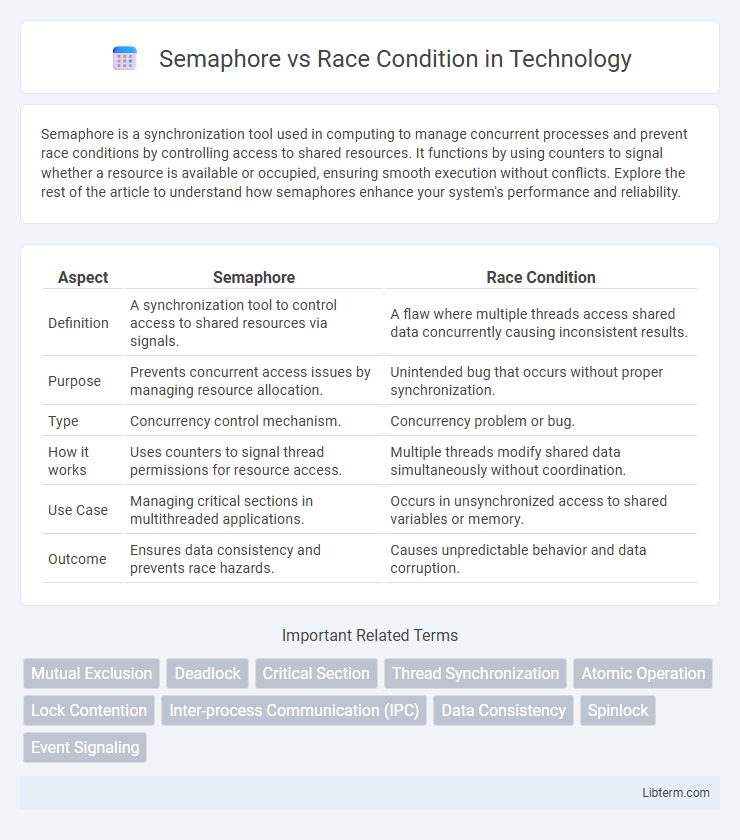Semaphore is a synchronization tool used in computing to manage concurrent processes and prevent race conditions by controlling access to shared resources. It functions by using counters to signal whether a resource is available or occupied, ensuring smooth execution without conflicts. Explore the rest of the article to understand how semaphores enhance your system's performance and reliability.
Table of Comparison
| Aspect | Semaphore | Race Condition |
|---|---|---|
| Definition | A synchronization tool to control access to shared resources via signals. | A flaw where multiple threads access shared data concurrently causing inconsistent results. |
| Purpose | Prevents concurrent access issues by managing resource allocation. | Unintended bug that occurs without proper synchronization. |
| Type | Concurrency control mechanism. | Concurrency problem or bug. |
| How it works | Uses counters to signal thread permissions for resource access. | Multiple threads modify shared data simultaneously without coordination. |
| Use Case | Managing critical sections in multithreaded applications. | Occurs in unsynchronized access to shared variables or memory. |
| Outcome | Ensures data consistency and prevents race hazards. | Causes unpredictable behavior and data corruption. |
Understanding Semaphores: Definition and Purpose
Semaphores are synchronization tools used in concurrent programming to control access to shared resources by multiple processes or threads, preventing race conditions. They operate by maintaining a counter that tracks resource availability, allowing processes to wait or proceed based on semaphore signals. Understanding semaphores is essential for managing resource allocation efficiently and ensuring consistent program execution without conflicts.
Defining Race Condition: Core Concepts
A race condition occurs when multiple processes or threads access shared resources concurrently, and the system's behavior depends on the sequence or timing of uncontrollable events. This leads to unpredictable outcomes, data corruption, or inconsistent results, making it a critical issue in concurrent programming. Semaphores are synchronization tools designed to prevent race conditions by controlling access to shared resources, ensuring only one thread modifies data at a time.
How Semaphores Prevent Race Conditions
Semaphores control access to shared resources by using signaling mechanisms that allow only a limited number of threads to enter critical sections, effectively preventing race conditions caused by concurrent modifications. By maintaining a counter that tracks resource availability, semaphores ensure serialized access, avoiding the overlapping operations that lead to data inconsistencies. This synchronization technique guarantees that only one thread accesses critical data at a time, promoting thread-safe execution and preserving data integrity.
Critical Sections: The Battleground for Race Conditions
Critical sections are areas of code where shared resources are accessed, making them prime battlegrounds for race conditions that occur when multiple threads modify data concurrently without proper synchronization. Semaphores control access to these critical sections by using signaling mechanisms to limit the number of threads entering simultaneously, effectively preventing race conditions. Without semaphores or similar synchronization tools, race conditions can cause inconsistent data states, crashes, or unpredictable behavior in concurrent programming environments.
Types of Semaphores: Counting vs Binary
Counting semaphores manage access to a finite number of resources by allowing multiple threads to enter critical sections concurrently up to a specified limit, while binary semaphores function as simple locks with only two states, signaling resource availability or unavailability. Race conditions occur when multiple threads access and manipulate shared data simultaneously without proper synchronization, leading to unpredictable results, which semaphores help prevent. Understanding the distinction between counting and binary semaphores is crucial for implementing effective thread synchronization and avoiding race conditions in concurrent programming environments.
Common Causes of Race Conditions in Multithreading
Race conditions in multithreading commonly arise from unsynchronized access to shared resources, causing unpredictable behavior. Semaphore mechanisms control concurrent access by enforcing limits, preventing conflicting thread execution. Failure to use proper synchronization tools like semaphores often leads to data corruption and inconsistent program states.
Practical Examples: Semaphores in Action
Semaphores are utilized in multithreading environments to prevent race conditions by controlling access to critical sections through signaling mechanisms; for instance, a counting semaphore limits the number of threads accessing a shared resource like a database connection pool. In contrast, race conditions occur when multiple threads concurrently modify shared data without synchronization, often leading to inconsistent or unpredictable results, such as simultaneous updates to a file or variable without locks. Practical applications of semaphores include controlling producer-consumer problems where semaphores manage buffer slots, ensuring data integrity by serializing thread operations and preventing race conditions.
Limitations of Semaphores in Synchronization
Semaphores can cause deadlocks if not managed carefully, leading to processes waiting indefinitely for resources. They lack the ability to enforce priority, which may result in priority inversion where higher-priority tasks are blocked by lower-priority ones. Complex logic and improper semaphore usage increase the risk of race conditions instead of preventing them, limiting their effectiveness in synchronization.
Best Practices to Avoid Race Conditions
Implementing semaphores effectively controls access to critical sections, preventing race conditions by ensuring that only one process can access shared resources at a time. Best practices include setting appropriate semaphore values, minimizing the scope of locked sections, and using atomic operations to avoid deadlocks and resource starvation. Consistently applying these techniques enhances concurrency control and maintains data integrity in multi-threaded environments.
Semaphore vs Race Condition: Key Takeaways and Comparison
Semaphore is a synchronization mechanism used to control access to a common resource in concurrent programming, preventing race conditions by managing multiple threads or processes. Race condition occurs when two or more threads access shared data simultaneously, leading to unpredictable and erroneous behavior due to improper synchronization. Semaphores effectively mitigate race conditions by signaling and locking, ensuring safe and ordered execution of critical sections in multithreaded environments.
Semaphore Infographic

 libterm.com
libterm.com